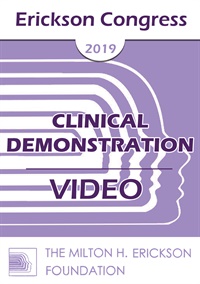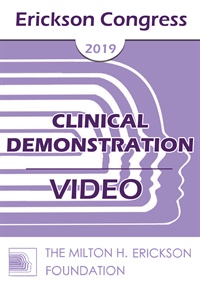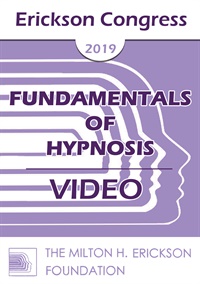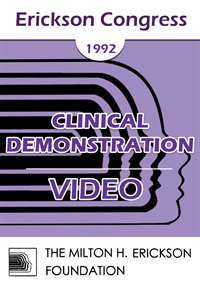- Average Rating:
- Not yet rated
- Topic Areas:
- Clinical Demonstrations | Utilization | Dissociation | Hypnosis
- Categories:
- Erickson Congress | Erickson Congress 2019
- Faculty:
- Brent Geary, PhD
- Course Levels:
- Master Degree or Higher in Health-Related Field
- Duration:
- 58 Minutes
- Format:
- Audio and Video
- Original Program Date:
- Dec 15, 2019
- Short Description:
- Dissociation is a critical element in hypnosis. But its converse, association, is highly useful in generating individualized hypnotic therapy. This demonstration will illustrate the importance of utilizing associations of both the subject and the hypnotist.
- Price:
-
Sale is $29.00
price reduced from Base Price - $59.00
Tags: Dissociation Hypnosis Utilization
- Average Rating:
- Not yet rated
- Topic Areas:
- Clinical Demonstrations | Ericksonian Psychotherapy | Psychotherapy | Dissociation | Trance
- Categories:
- Erickson Congress | Erickson Congress 2019
- Faculty:
- Teresa Robles, MA, PhD
- Course Levels:
- Master Degree or Higher in Health-Related Field
- Duration:
- 1 Hour 3 Minutes
- Format:
- Audio and Video
- Original Program Date:
- Dec 14, 2019
- Short Description:
- In this demonstration I will present how to introduce to the client the concept of Universal Wisdom and how to utilize it during the session. We are going to work with the minimum information about the problem because we are going to work with what I call Universal Topics that underly the problem. The problem will be treated with several different mini trances that trigger processes that will continue in the hands of Universal Wisdom.
- Price:
-
Sale is $29.00
price reduced from Base Price - $59.00
Tags: Dissociation Trance
- Average Rating:
- Not yet rated
- Topic Areas:
- Fundamentals of Hypnosis | Dissociation | Hypnosis
- Categories:
- Erickson Congress | Erickson Congress 2019
- Faculty:
- Michael Yapko, PhD
- Course Levels:
- Master Degree or Higher in Health-Related Field
- Duration:
- 1 Hour 15 Minutes
- Format:
- Audio and Video
- Original Program Date:
- Dec 15, 2019
- Short Description:
- A primary feature of hypnosis is dissociation, defined as the breaking of global experiences into their component parts. Dissociation gives rise to some of the most fascinating practical aspects of hypnosis in clinical contexts, such as pain management and the revivification of memories. Dissociation also paves the way for suggested responses to arise seemingly spontaneously, an enormously advantageous phenomenon called automaticity. In this workshop, we will consider the therapeutic roles of dissociation and automaticity and conduct an exercise in generating an “automatic” response.
- Price:
-
Sale is $29.00
price reduced from Base Price - $59.00
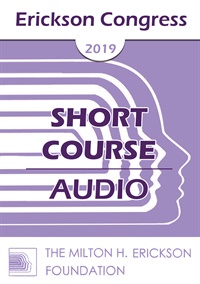
- Average Rating:
- Not yet rated
- Topic Areas:
- Short Courses | Hypnosis | Unconscious Processes | Dissociation | Psychology
- Categories:
- Erickson Congress | Erickson Congress 2019
- Faculty:
- Jesus Menendez Reyes
- Duration:
- 1 Hour 21 Minutes
- Format:
- Audio Only
- Original Program Date:
- Dec 12, 2019
- Short Description:
- This presentation will review the concept of dissociation and its evolution in modern Psychology and its relationship with hypnotic process, when it is described as a mind state of focused attention. We will explore the idea of dissociation between the conscious and unconscious mind during hypnosis and how it can lead to therapeutic success. Some practical exercises and demonstrations to provoke dissociate states.
- Price:
- $15.00 - Base Price
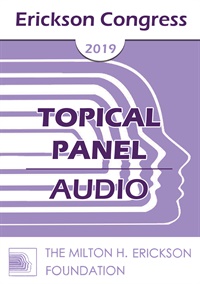
- Average Rating:
- Not yet rated
- Topic Areas:
- Workshops | Dissociation | Trauma | Hypnosis | Therapeutic Relationship
- Categories:
- Erickson Congress | Erickson Congress 2019
- Faculty:
- Camillo Loriedo, MD, PhD
- Duration:
- 1 Hour 54 Minutes
- Format:
- Audio Only
- Original Program Date:
- Dec 13, 2019
- Short Description:
- Dissociation can be described as the failure to integrate information and self-attributions that should ordinarily be integrated, and as alterations of consciousness characterized by a sense of detachment from the self and/or the environment. The strong connection between Hypnosis and Dissociation is known since the time of Pierre Janet's pioneer work. Dissociative hypnotic intervention demonstrated to be very useful in treating pain, anxiety disorders and many other conditions.
- Price:
- $15.00 - Base Price
- Average Rating:
- Not yet rated
- Topic Areas:
- Clinical Demonstrations | Dissociation | Hypnosis
- Categories:
- Erickson Congress | Erickson Congress 1992
- Faculty:
- Stephen Lankton, MSW
- Course Levels:
- Master Degree or Higher in Health-Related Field
- Duration:
- 55:58
- Format:
- Audio and Video
- Original Program Date:
- Dec 04, 1992
- Short Description:
- IC92 Clinical Demonstration 12 - The Role of Association and Dissociation in Co-Creating Experience in Therapy - Stephen Lankton, MSW
- Price:
- $29.00 - Base Price
Tags: Dissociation Hypnosis
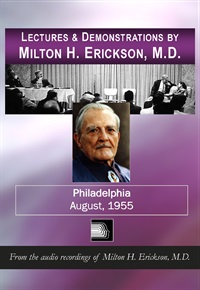
- Average Rating:
- Not yet rated
- Topic Areas:
- Hypnosis | Milton Erickson | Dissociation | Unconscious Processes | Ericksonian Hypnosis and Therapy Techniques
- Categories:
- Erickson Materials | Lectures & Demonstrations | Milton H. Erickson Collections
- Faculty:
- Milton H. Erickson, MD
- Duration:
- 2:17:27
- Format:
- Audio Only
- Original Program Date:
- Aug 01, 1955
- Short Description:
- In this set, Erickson communicates the timeless principles of hypnosis that he observed, discovered and utilized. He emphasizes the paramount importance of protecting the patient and establishing trust as the very foundation of the cooperative relationship characteristic of hypnosis. He stresses the importance of understanding the meaningful need of the patient and reviews, with many examples, the techniques of rehearsal, uncovering, dissociation, regression, time-distortion, revivification, visualization, orientation to the past and to the future, trusting the unconscious mind, and post-hypnotic suggestion.
- Price:
- $20.00 - Base Price
Please wait ...


